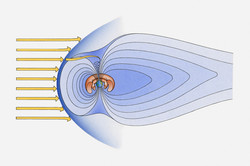Space weather links to the plasmasphere
The outer Van Allen radiation belt is much more dynamic than the inner one. It is readily affected by solar storms that impact the Earth's magnetosphere. At such times, the density of high-energy electrons and protons can vary by several orders of magnitude. During these so-called geomagnetic storms, space assets such as satellites are in danger. The radiation belts overlap with the plasmasphere, a doughnut-shaped region of low-energy particles that co-rotates with the Earth. EU-funded scientists initiated the project PLASMON (A new, ground based data-assimilative modeling of Earth's plasmasphere - A critical contribution to radiation belt modeling for space weather purposes) to elucidate the role of the plasmasphere in the dynamics of the radiation belts. The plasmasphere determines the growth and propagation of plasma waves that are responsible for the energisation of the radiation belts and particle loss through wave-particle interaction. PLASMON scientists attempted to identify and monitor how the two populations of particles interact through measurements by ground-based magnetometers. The Automatic Whistler Detector and Analyzer Network (AWDANet) was extended and enhanced by whistler inversion capabilities and now it is able to provide plasmaspheric electron densities quasi real-time. In addition, the existing MM100 and SEGMA magnetometer networks were extended with new stations in Croatia, Lithuania, Namibia, Poland and Slovakia forming European Magnetometer Network (EMMA) obtaining plasma mass densities by Field Line Resonances (FLRs). Very precise and complementary data collected at the same time and in different places helped to reveal changes in the densities in the plasmasphere . However, measurements only partly cover the plasmasphere. PLASMON scientists needed a global map of the plasma density in both time and space to determine the effect of wave-particle interactions on the radiation belts' dynamics. Data was, therefore, incorporated into a numerical model of the plasmasphere with advanced data assimilation schemes. This physics-based model of the plasmasphere, continuously fed with new measurements, was used to identify structures inside or outside the plasmapause that are likely to result in enhanced electron losses. The PLASMON scientists monitored relativistic electron precipitation during periods of high geomagnetic activity by means of the perturbation of military VLF transmitters'. The presence of the radiation belts is a key factor in the design and operation of all spacecraft in low Earth orbit, as well as a natural hazard for astronauts. Accurate predictions of the dynamics of the belts were one of the prime objectives of the PLASMON project, and this was achieved by better understanding the underlying physics.
Keywords
Space weather, plasmasphere, Van Allen radiation belts, whistler, FLR, data assimilation, VLF transmitter, geomagnetic activity



